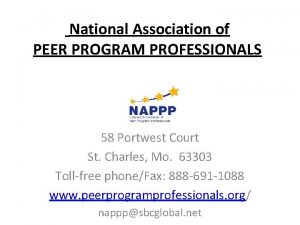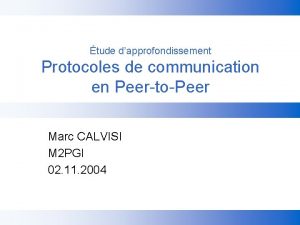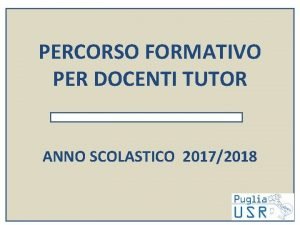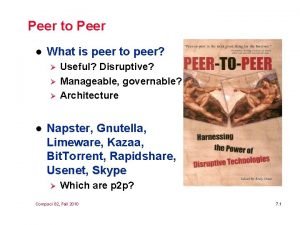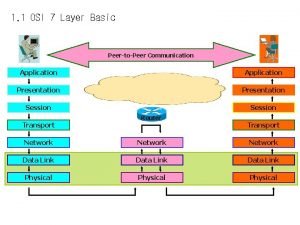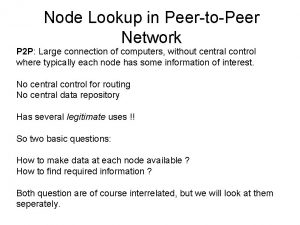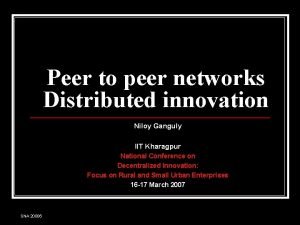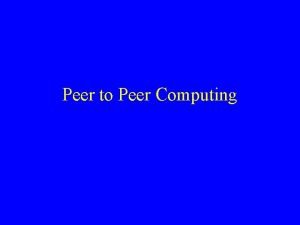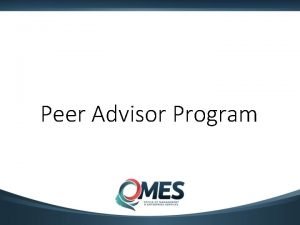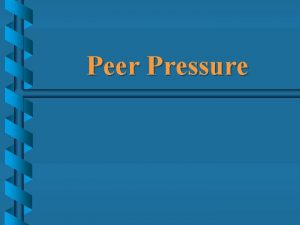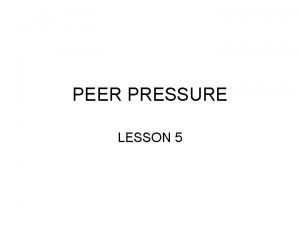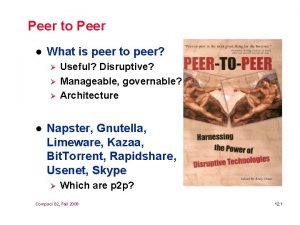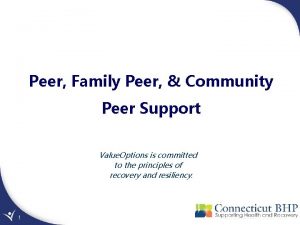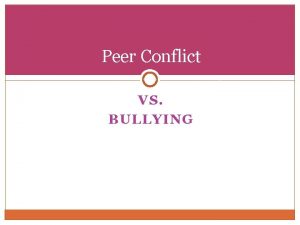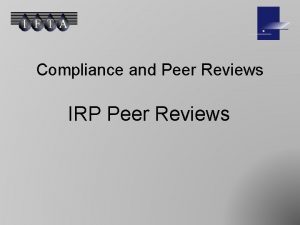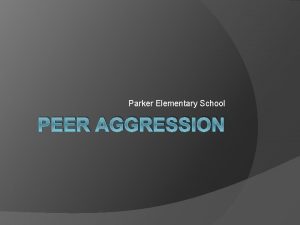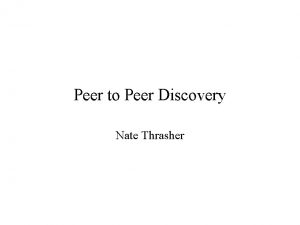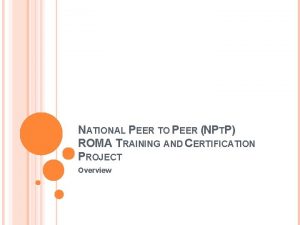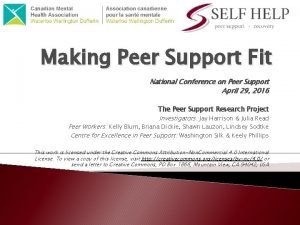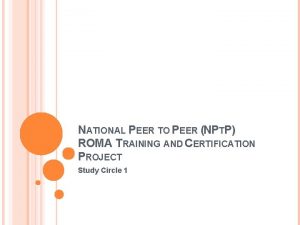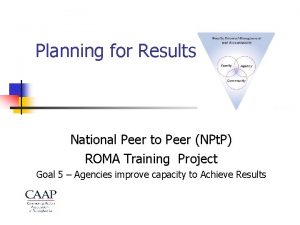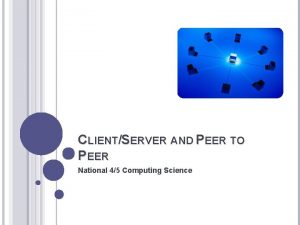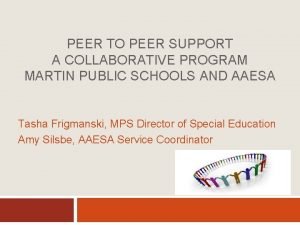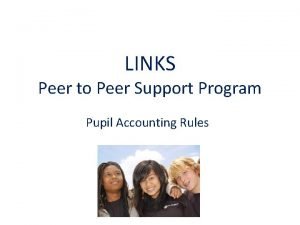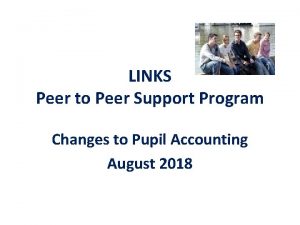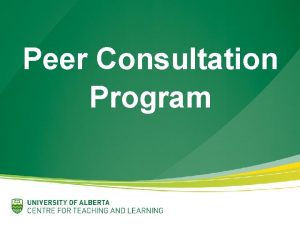National Association of PEER PROGRAM PROFESSIONALS 58 Portwest























- Slides: 23

National Association of PEER PROGRAM PROFESSIONALS 58 Portwest Court St. Charles, Mo. 63303 Toll-free phone/Fax: 888 -691 -1088 www. peerprogramprofessionals. org/ nappp@sbcglobal. net

Ethical Dilemmas at the High School and Higher Education Level • Learn Ethical Guidelines for Peer Programs based on NAPPP Programmatic Standards and Ethics. • Explore issues and dilemmas peer program professionals face in working with peer programs. • Follow a framework to resolving Ethical dilemmas. • Participate in dialogue about ethical situations.

NATIONAL ASSOCIATION OF PEER PROGRAM PROFESSIONALS CODE OF ETHICS FOR PEER HELPING PROFESSIONALS • A philosophy which upholds peer helping is an effective way to address the needs and conditions of people. • A commitment to an individual's right to dignity, self-development, and self-direction. • Excellence in program development and implementation which demonstrates:

Cont. • A strong positive rapport with peer helpers. • Appropriate background, training, and skills • Personal commitment to the peer-helping program. • Integrity of acquiring necessary training for specific work with students (e. g. , tutoring, mediation, etc. ). • Utilization of a training curriculum that is aligned with NAPPP Programmatic Standards.

Cont. • The Development of a nurturing personality which: – – Reflects a positive role model and healthy lifestyle Reject the pursuit of personal power or gain at the expense of others. Respect copyright and acknowledgment obligations. Adhere to the ethics and legalities of confidential issues (abuse and harm to self and others). – Strives to exemplify the peer helping philosophy in all life situations

CODE OF ETHICS FOR PEER HELPERS • A CODE OF ETHICS IS AN AGREEMENT AMONG THOSE WHO COMMIT TO THE PROGRAM AS TO THE NORMS THAT SHALL GUIDE THEIR BEHAVIOR DURING THEIR INVOLVEMENT IN THE PROGRAM.

Code of Ethics for Peer Helpers shall be people of personal integrity. NAPPP believes peer helpers will……. . • 1. Embrace the philosophy that peer helping is an effective way to address the needs and conditions of people. • 2. Respect the individual's right to dignity, selfdevelopment, and self-direction. • 3. Model positive behaviors and life choices (e. g. , no substance use/abuse). • 4. Embrace the concept of service to others for the good of the community.

Cont. • 5. Maintain confidentiality of information imparted during the course of program related activities with the exceptions of child abuse, sexual abuse, family dysfunction, psychotic behavior, harm to self and others, and drug and alcohol abuse. • 6. Refrain from tackling situations for which they have no training and preparation (e. g. , peer mediation, tutoring, etc. ). • 7. Recognize, report, and know techniques to deal with stated or implied threats to their emotional or physical well being. • .

Key Terms Values: Inner standards to motivate actions, by which we judge behavior (ours and others) Ethics: System of principles of conduct based on moral values Code of Conduct: Rules, standards, codes, or principles that provide guidelines for morally “right” behavior and truthfulness in a particular group. Dilemma: Situation has no clear “right” or good solution.

Basic Principals of a Code of Ethics • Beneficence (practice of doing good) • Non-malfeasance (no evil doing) • Autonomy (the right of the individual to make own choices; limited with minors) • Justice (impartiality, fairness, sound reason) • Fidelity (faithful observance of duty and obligations)

Ethical Issues Faced as a Peer Program Professional • Peer Program Professional • Peer Helper

Framework in Examining Ethical Issues • • • Gather facts—separate fact from opinion Consider who is involved—who is affected by the decision making process Identify key issues Evaluate options and alternatives (consult with others) Decide on the best course of action

Gather Facts Jessica has been helping Morgan who is an 18 -year-old female who was only able to finish the 8 th grade. Morgan has difficulties learning new skills and can’t seem to pass the her classes. Because of what appears to be her “slowness” and her appearance, she is often teased by peers. This makes her very angry and she has started to withdraw from people and activities. She is starting to give away some personal belongings and recently told a friend that she had “had enough. ” Jessica told her to call the suicide hotline the next day. Jessica is sharing the situation in her weekly meeting with her peer helping class.

Consider who is involved—who is affected by the decision making process • • Jessica Morgan Peer Programs Professional Peer Helping Class

Identify key issues • Morgan possibly suicidal. • Jessica did not go to the peer programs professional immediately. • Not following the Ethical Code • Safety of Morgan. • Impact on others in the peer helping class.

Evaluate options and alternatives (consult with others) • Peer Program Educator discuss situation with other peer program educators. • Peer Program Educator meet with Jessica to verify information. • Peer Program Educator along with the School Counselor discuss with Morgan how she is feeling in reference to suicide and explain that Jessica and to consult with them. • Peer Program Educator discuss with total peer helping group about the situation and ethical guidelines ? • Peer Program Educator train again on suicidal intervention and referral.

Decide on the best course of action • The Peer Program Educator meets with Jessica to discuss confidentiality and what must be reported. Ask Jessica to review the training again on suicide intervention and referral and ask her to write a report about the process. • The Counselor and Peer Program professional meet with Morgan to evaluate her mental health needs and refer to appropriate help. Also, call her parents since she is 16. • The Peer Helping class will have a refresher course on suicide prevention and intervention.

Ethical Considerations for High School Peer Programs • Confidentiality • Referral Process for things such as violence, physical, sexual abuse, drug and alcohol problems, illegal acts, serious emotional problems and suicidal threats. • Role Model for other students • Appropriate Application of Student Skills • Transfer of skills to Daily Life

Appropriate Application of Student Peer Helping Skills Service Delivery Activities for this age are: • • Tutoring Mentors Peer Counselors and Helpers New Student Buddies Bullying Prevention/Intervention Peer Mediation Health Educators Youth Saving youth

Appropriate Roles • • • Special Friends Cyber Bullying Education and Bullying-free Leaders One-on-one helping Big Brother Big Sister Group Leader Peer Program Trainer Special Day Sponsor Prevention theater Peer athletic team helpers

Ethical Situations • • Review list of possible Ethical Situations Discuss in Small Groups Report out to Large Group Follow the steps identified earlier

Resources: Webinars § • • • Suicide Prevention/Intervention: Peer to Peer Strategies– March 20, 2013 - Order through book store Bullying Prevention and Intervention for Schools: Peer to Peer Strategies - March 28, 2012 - May order on line Evaluation: Building Success from the Beginning Peer and Prevention Programs – Sept. 27, 2012 - may order on line Ethical Dilemmas in Peer Helping and Prevention Field -Sept. 25 - may order on line Presented in collaboration with Youthlight Available on NAPPP website

Resources Cont. • NAPPP Trainer/Consultants • www. peerprogramprofessionals. org • “Peer Power Book One” Strategies for the Professional Leader • “Peer Power Book One, Workbook” Available from NAPPP Book Store Judith A. Tindall, Ph. D. CPPE, CTC, 58 Portwest Ct. St. Charles, Mo. 63303, psynetinc@sbcglobal. net
 National peer helpers association
National peer helpers association Annotazioni sulla verifica effettuata peer to peer
Annotazioni sulla verifica effettuata peer to peer Peer-to-peer
Peer-to-peer Peer to peer transactional replication
Peer to peer transactional replication Peer to peer transactional replication
Peer to peer transactional replication Gambar topologi peer to peer
Gambar topologi peer to peer Registro peer to peer compilato
Registro peer to peer compilato Esempi di peer to peer compilati scuola primaria
Esempi di peer to peer compilati scuola primaria Relazione finale docente tutor compilata
Relazione finale docente tutor compilata Peer to peer l
Peer to peer l Peer to peer merupakan jenis jaringan… *
Peer to peer merupakan jenis jaringan… * Bitcoin: a peer-to-peer electronic cash system
Bitcoin: a peer-to-peer electronic cash system Features of peer to peer network and client server network
Features of peer to peer network and client server network Programmazione e sviluppo condiviso compilato
Programmazione e sviluppo condiviso compilato Peer-to-peer communication in osi model
Peer-to-peer communication in osi model Peer to peer vorteile nachteile
Peer to peer vorteile nachteile Addresss look up
Addresss look up Peer-to-peer o que é
Peer-to-peer o que é Peer to peer computing environment
Peer to peer computing environment Peer intervention program
Peer intervention program Peer-to-peer o que é
Peer-to-peer o que é Peer-to-peer o que é
Peer-to-peer o que é Peer to peer network hardware
Peer to peer network hardware Peer to peer chat application in java
Peer to peer chat application in java
